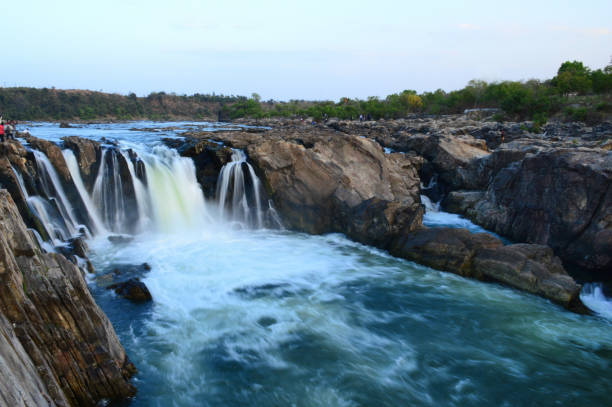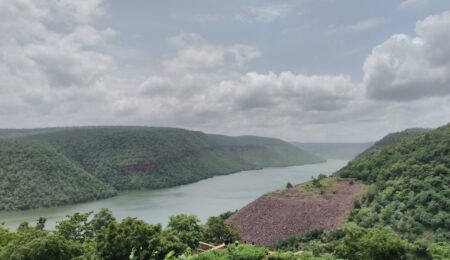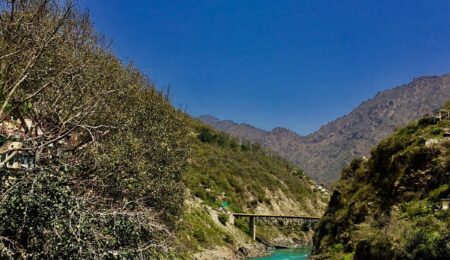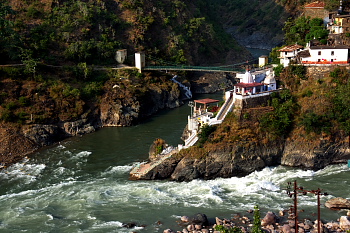
Flowing through the heartland of India, the Narmada River is a sacred waterway that holds profound spiritual significance. Revered as one of the holiest rivers in the country, the Narmada carves its way through the states of Madhya Pradesh, Maharashtra, and Gujarat, blessing the landscape with its pristine waters and captivating beauty. Embarking on a journey spanning centuries, the Narmada River is not just a physical entity but a symbol of devotion, purity, and the timeless bond between humans and nature.
The Narmada River originates from the Maikal Hills in Amarkantak, Madhya Pradesh, where it is believed to emerge from the foot of Lord Shiva. It meanders through the central Indian plateau, gradually widening its course and flowing westward before emptying into the Arabian Sea. Along its 1,312-kilometer-long journey, the Narmada blesses the region with fertile plains, lush forests, and awe-inspiring landscapes.
The Narmada River has a rich spiritual heritage that dates back to ancient times. It is mentioned in several Hindu scriptures, including the Vedas and the Puranas, where it is hailed as a sacred river capable of purifying sins and bestowing blessings. The Narmada is often personified as a goddess, and devotees revere her as Narmada Maiyya, the mother who nurtures and protects all life.

The Narmada River is considered to be one of the most sacred rivers in Hinduism. A dip in the river is believed to cleanse one of all their sins. The river is also considered to be a holy place for pilgrimage. Every 12 years, a massive religious fair known as the “Kumbh Mela” is held at the confluence of the Narmada and the Shipra rivers. Millions of people come from all over the world to dip in the river and receive its blessings.
The Narmada River is also an important water source for the state of Madhya Pradesh. The river provides water to a large number of people for their daily needs, as well as for irrigation and other purposes. The river is also home to a number of hydroelectric power plants, which generate a significant amount of electricity for the state. The Narmada River is also an important water source for the people of India. It is one of the major rivers that provide water to the country and is used for irrigation, drinking, and other purposes. The river is also home to many fish and is a popular spot for fishing.
Pilgrimage along the Narmada River is a deeply transformative and spiritually rewarding experience. The Narmada Parikrama, a circumambulation of the river, is a sacred journey undertaken by devout pilgrims. The parikrama covers a distance of approximately 2,600 kilometres, tracing the river’s course from its origin to its confluence with the Arabian Sea. Pilgrims walk barefoot, chanting hymns and offering prayers, immersing themselves in the divine energy of the river and seeking spiritual enlightenment.
The banks of the Narmada are adorned with numerous temples, ashrams, and pilgrimage sites that attract devotees from far and wide. Omkareshwar, located on an island in the Narmada, is home to one of the twelve Jyotirlingas, the sacred abodes of Lord Shiva. Maheshwar, another renowned town on Narmada’s banks, houses the famous Maheshwar Temple, dedicated to Lord Shiva. These places resonate with spiritual vibrations, drawing devotees and seekers to experience the divine presence.
Buddhism began to spread through the Indian subcontinent in the 5th century BCE and soon became one of the major religions in the region. The Narmada River was an important part of the religious landscape and was considered to be a holy site. The river was believed to be the home of many gods and goddesses and was said to be where the Buddha himself had attained enlightenment. The Narmada River is still an important part of Buddhist religious practice today. Many pilgrims travel to the river to bathe in its waters, which are considered holy and cleansing. The river is also a popular destination for meditation and contemplation.
One of the most revered festivals associated with the Narmada River is the Narmada Jayanti, which marks the birth anniversary of the river. Devotees gather large numbers to offer prayers, take holy dips, and participate in processions along the riverbanks. The festival celebrates the river’s life-giving properties and its role in nurturing nature and humanity.
The Narmada River is a spiritual and cultural symbol and a lifeline for the communities residing along its banks. The river sustains agriculture, providing water for irrigation and supporting the growth of crops such as wheat, cotton, and soybeans. Fishing communities depend on the river for their livelihood, casting their nets to catch various freshwater fish. The fertile soil of the Narmada basin supports a diverse range of flora and fauna, contributing to the region’s biodiversity.
Despite its revered status, the Narmada River faces challenges in the form of pollution and environmental degradation. Industrial waste, untreated sewage, and deforestation have affected the river’s health. However, there have been efforts to revive and protect the Narmada through initiatives like the Narmada Clean-up Project and the Narmada Seva Yatra, which aim to raise awareness, promote sustainable practices, and restore the river’s pristine state.
Visiting the Narmada River is an opportunity to immerse oneself in the divine embrace of nature. The tranquil surroundings, the gurgling waters, and the spiritual fervour create a sense of serenity and connection with the sacred. Taking a dip in the Narmada is believed to cleanse one’s soul and bring blessings while witnessing the aartis (devotional rituals) and participating in the bhajans (devotional songs) further deepen the spiritual experience.
In conclusion, the Narmada River is not just a waterway; it is a spiritual and cultural emblem that resonates with the hearts and souls of millions. It embodies the eternal bond between humans and nature, reminding us of the interdependence and sacredness of all life. As we strive to protect and preserve the Narmada, let us honour its sanctity, cherish its beauty, and ensure that future generations can continue to experience the divine journey offered by this holy river.




